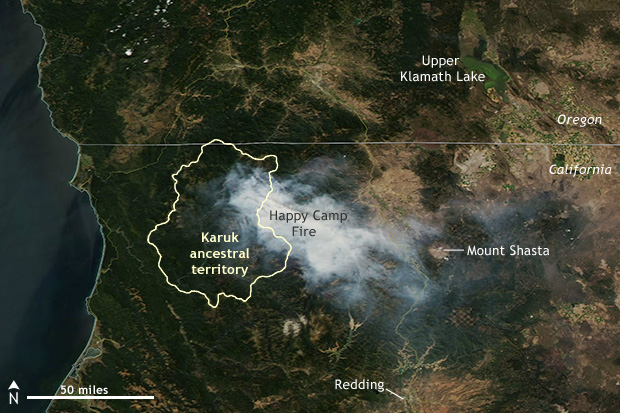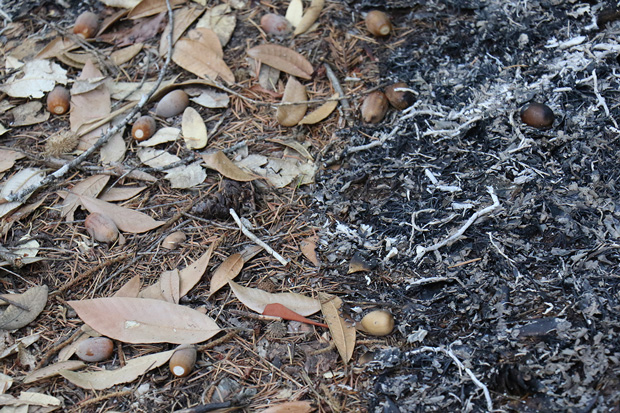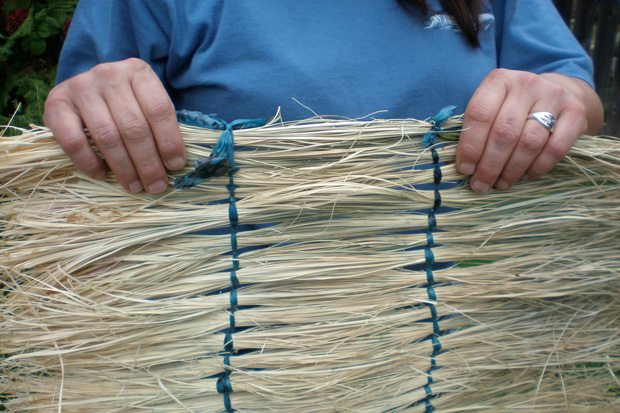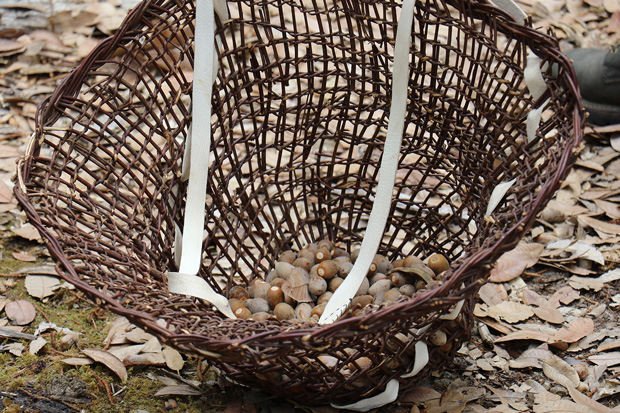Fires in Northern California Present Challenges to Native Tribes
Special Stories
29 Nov 2018 1:09 PM
[A 2011 controlled burn in a tan oak gathering area creates defensible space below a nearby home while increasing the quality of the acorns by interrupting the life cycle of the acorn weevil. Photo courtesy Mid Klamath Watershed Council via NOAA Climate]
[NOAA] Fire is foundational to the Karuk Tribe, who live and manage 1.048 million acres of their aboriginal lands along the Klamath and Salmon Rivers in northern California. By removing accumlated fuels, fire makes room for new growth and change. This renewal helps ensure the quality of traditional foods and cultural materials and serves as a medium of cultural education. Ceremonies surrounding fire strengthen the Tribe's social networks and enhance its members' physical and mental health.
The Tribe's proactive cultural use of fire also protects the Klamath River basin by reducing the availability of forest fuels—and thus reducing the risk of high-severity wildfire that can threaten people, their homes and businesses, and natural systems such as forests and wetlands near rivers and streams.
Wildland systems in the Klamath River range have evolved alongside Karuk management practices for thousands of years. Tribal families continue to use traditional forest management techniques—including low-intensity prescribed burns—to cultivate the forest to become a more productive resource for food and cultural materials and to reduce the availability of forest fuels. Tribal programs support and expand upon their work.
 [The Karuk tribe's ancestral lands (outlined in yellow) lie along the Klamath River in northern California, northwest of Redding. Natural-color satellite image from NASA's Terra satellite on August 31, 2014, during the time of the Happy Camp Fire, the state's largest fire that year. Karuk territory outline digitally adapted from original map by Conservation International, appearing in Salmon Feeds our People.]
[The Karuk tribe's ancestral lands (outlined in yellow) lie along the Klamath River in northern California, northwest of Redding. Natural-color satellite image from NASA's Terra satellite on August 31, 2014, during the time of the Happy Camp Fire, the state's largest fire that year. Karuk territory outline digitally adapted from original map by Conservation International, appearing in Salmon Feeds our People.]
 [Tanoak acorns (xuntápan) are a staple Native food for many indigenous people and are also vital for numerous wildlife species. Additionally, the roots of tanoak trees support the growth of another important food, tanoak mushrooms. Tanoak (xunyêep) is very susceptible to high-intensity fire, but benefits from cultural burning that decreases tree and acorn pests and reduces competitive vegetation. Photo courtesy the U.S. Climate Resilience Toolkit.]
[Tanoak acorns (xuntápan) are a staple Native food for many indigenous people and are also vital for numerous wildlife species. Additionally, the roots of tanoak trees support the growth of another important food, tanoak mushrooms. Tanoak (xunyêep) is very susceptible to high-intensity fire, but benefits from cultural burning that decreases tree and acorn pests and reduces competitive vegetation. Photo courtesy the U.S. Climate Resilience Toolkit.]
 [Beargrass—or panyúrar in Karuk—is an important species for basket weavers and regalia makers. The blades that grow the first year after a fire are considered best for basket weaving. Panyúrar can be stimulated by fire, and is fire-adapted in that it can sprout from rhizomes following fire or re-establish by seed. At the same time, panyúrar can be damaged by fires that burn too hot. Photo courtesy the U.S. Climate Resilience Toolkit.]
One report—Karuk Traditional Ecological Knowledge and the Need for Knowledge Sovereignty—emphasizes two key concepts:
[Beargrass—or panyúrar in Karuk—is an important species for basket weavers and regalia makers. The blades that grow the first year after a fire are considered best for basket weaving. Panyúrar can be stimulated by fire, and is fire-adapted in that it can sprout from rhizomes following fire or re-establish by seed. At the same time, panyúrar can be damaged by fires that burn too hot. Photo courtesy the U.S. Climate Resilience Toolkit.]
One report—Karuk Traditional Ecological Knowledge and the Need for Knowledge Sovereignty—emphasizes two key concepts:
 [A traditional Karuk basket with tannoak acorns in the bottom. Photo courtesy the U.S. Climate Resilience Toolkit.]
[A traditional Karuk basket with tannoak acorns in the bottom. Photo courtesy the U.S. Climate Resilience Toolkit.]
 [The Karuk tribe's ancestral lands (outlined in yellow) lie along the Klamath River in northern California, northwest of Redding. Natural-color satellite image from NASA's Terra satellite on August 31, 2014, during the time of the Happy Camp Fire, the state's largest fire that year. Karuk territory outline digitally adapted from original map by Conservation International, appearing in Salmon Feeds our People.]
[The Karuk tribe's ancestral lands (outlined in yellow) lie along the Klamath River in northern California, northwest of Redding. Natural-color satellite image from NASA's Terra satellite on August 31, 2014, during the time of the Happy Camp Fire, the state's largest fire that year. Karuk territory outline digitally adapted from original map by Conservation International, appearing in Salmon Feeds our People.]
Traditional Karuk fire use
Indigenous burning is increasingly recognized as a component of the ecosystem and a restoration technique. Fire is important for restoring grasslands for elk, managing for food sources such as tan and black oak acorns, maintaining quality basketry materials, and producing smoke that can shade the river for fish. Karuk fire regimes generate what is known as "pyrodiversity"—the biodiversity consequences of fire management—on the landscape by extending the burning season and shortening the intervals of fire return. The multitude of foods, materials, and other products that come from Karuk lands are evidence of the profound diversity of fire regimes that are required to maintain relationships with hundreds of animal, plant, and mushroom species. Since European contact, non-native use and management of the region has severely impacted the Karuk people's access to cultural, ceremonial, and food resources. The region's weather variability has exacerbated these effects, and the Karuk are now experiencing a decline in the abundance of key species, including salmon, acorns, huckleberries, hazel, and willow. Natural disasters and hazards ranging from increasing frequency of high-severity wildfire to flooding and mudslides are on the rise—generating a range of negative human health outcomes for the Karuk people. [Tanoak acorns (xuntápan) are a staple Native food for many indigenous people and are also vital for numerous wildlife species. Additionally, the roots of tanoak trees support the growth of another important food, tanoak mushrooms. Tanoak (xunyêep) is very susceptible to high-intensity fire, but benefits from cultural burning that decreases tree and acorn pests and reduces competitive vegetation. Photo courtesy the U.S. Climate Resilience Toolkit.]
[Tanoak acorns (xuntápan) are a staple Native food for many indigenous people and are also vital for numerous wildlife species. Additionally, the roots of tanoak trees support the growth of another important food, tanoak mushrooms. Tanoak (xunyêep) is very susceptible to high-intensity fire, but benefits from cultural burning that decreases tree and acorn pests and reduces competitive vegetation. Photo courtesy the U.S. Climate Resilience Toolkit.]
Revitalizing Traditional Ecological Knowledge
In order to adapt to these and other ongoing challenges, the Karuk people are working to revitalize the Traditional Ecological Knowledge (TEK) inextricably tied to their ability to physically apply resource management practices. Fire has been a primary tool in Karuk wildland management systems, and the Tribe maintains that the age-old tradition of prescribed burning holds the answer to planning in the Klamath River range. The Tribe has researched and published two reports concerning social and environmental changes and the long-term effects the Karuk people are facing with regard to knowledge sovereignty and the vulnerability of their TEK, supported by the 2015 Tribal Cooperative Landscape Conservation Program administered by the U.S. Bureau of Indian Affairs Tribal Climate Resilience Program. [Beargrass—or panyúrar in Karuk—is an important species for basket weavers and regalia makers. The blades that grow the first year after a fire are considered best for basket weaving. Panyúrar can be stimulated by fire, and is fire-adapted in that it can sprout from rhizomes following fire or re-establish by seed. At the same time, panyúrar can be damaged by fires that burn too hot. Photo courtesy the U.S. Climate Resilience Toolkit.]
One report—Karuk Traditional Ecological Knowledge and the Need for Knowledge Sovereignty—emphasizes two key concepts:
[Beargrass—or panyúrar in Karuk—is an important species for basket weavers and regalia makers. The blades that grow the first year after a fire are considered best for basket weaving. Panyúrar can be stimulated by fire, and is fire-adapted in that it can sprout from rhizomes following fire or re-establish by seed. At the same time, panyúrar can be damaged by fires that burn too hot. Photo courtesy the U.S. Climate Resilience Toolkit.]
One report—Karuk Traditional Ecological Knowledge and the Need for Knowledge Sovereignty—emphasizes two key concepts:
- First, that TEK is not an isolated application, but a living system that requires ongoing practice in the landscape for survival. Preserving knowledge sovereignty is fundamentally about Karuk cultural management because this knowledge is embedded in, and emerges from, the practices of traditional management.
- Second, it is impossible—as well as unethical—to attempt to remove TEK from its original context. Efforts to extract knowledge are a form of cultural appropriation that erodes the very foundations of tribal life. Knowledge and management techniques are at the core of tribal identity, culture, spiritual practice, and subsistence economies. Karuk people need fire in order to restore the land, strengthen cultural relationships, revitalize ceremonial education, and protect all who inhabit the Klamath River region from the adverse effects of high-severity wildfire.
 [A traditional Karuk basket with tannoak acorns in the bottom. Photo courtesy the U.S. Climate Resilience Toolkit.]
[A traditional Karuk basket with tannoak acorns in the bottom. Photo courtesy the U.S. Climate Resilience Toolkit.]
Climate Vulnerability Assessment
In addition to the reports mentioned above, the Tribe has also undertaken and published the Karuk Climate Vulnerability Assessment (CVA), which addresses vulnerabilities to Karuk traditional foods and cultural use species, tribal program infrastructure, and management authority and political status that result from the increasing frequency of high-severity fire. The CVA makes the case that Karuk tribal knowledge and management principles regarding the use of fire can be utilized to reduce the likelihood of high-severity fires and thereby protect public, as well as tribal, trust resources.References:
Anderson, M. Kat, and Frank K. Lake, 2013: California Indian ethnomycology and associated forest management. Journal of Ethnobiology, 33(1):33–85, doi:http://dx.doi.org/10.2993/0278-0771-33.1.33. Edited for WeatherNation by Meteorologist Mace MichaelsAll Weather News
More